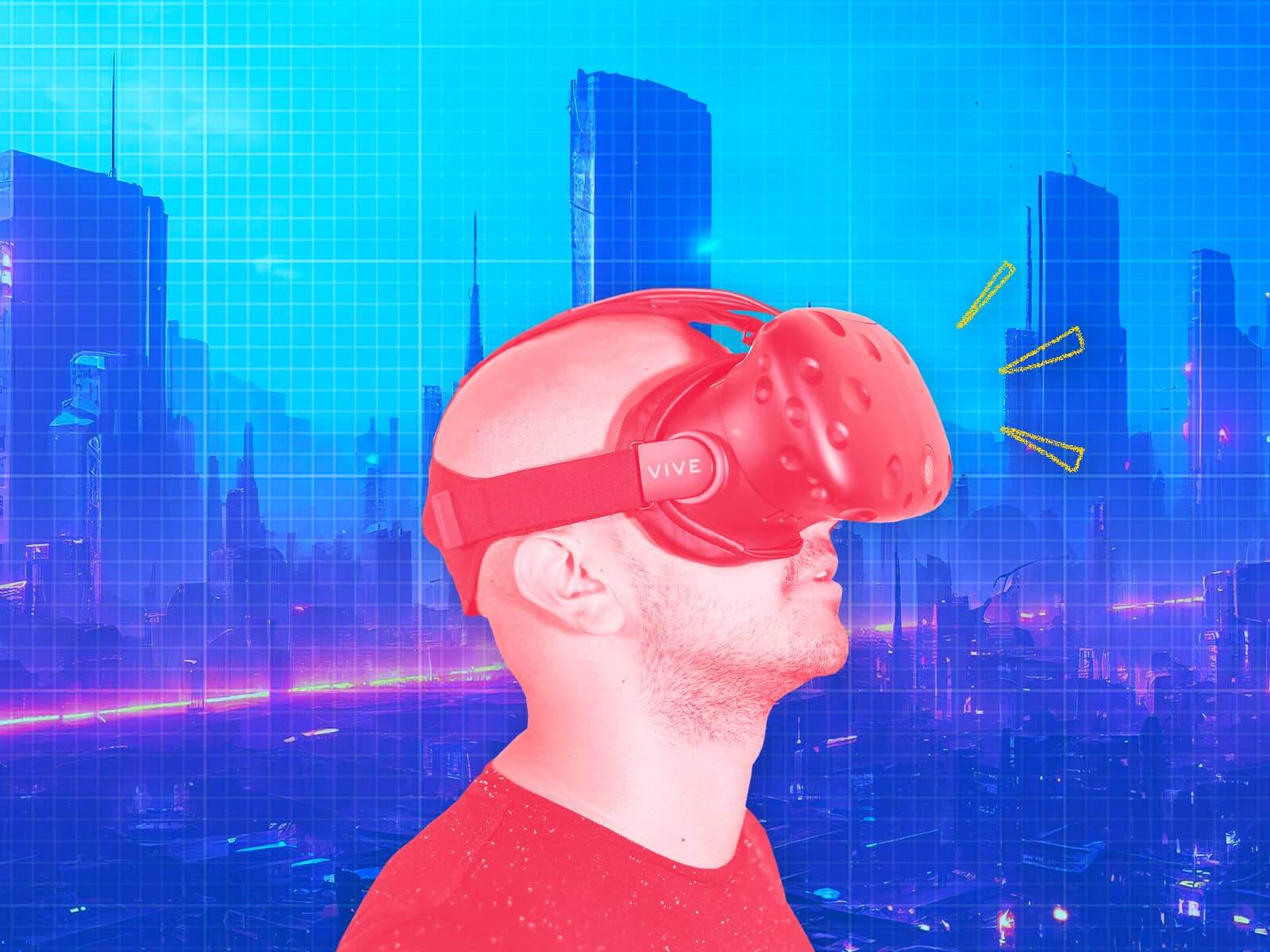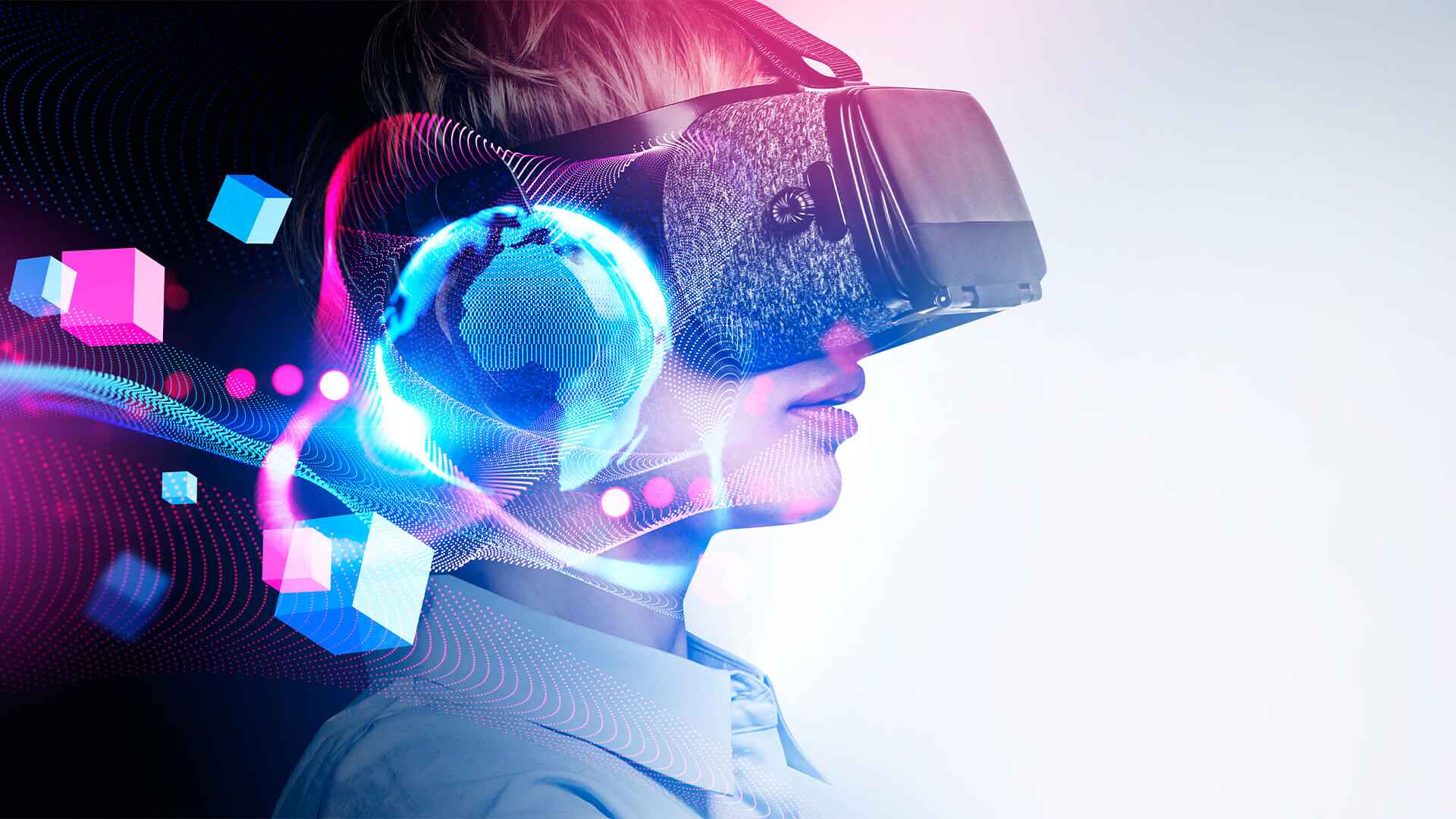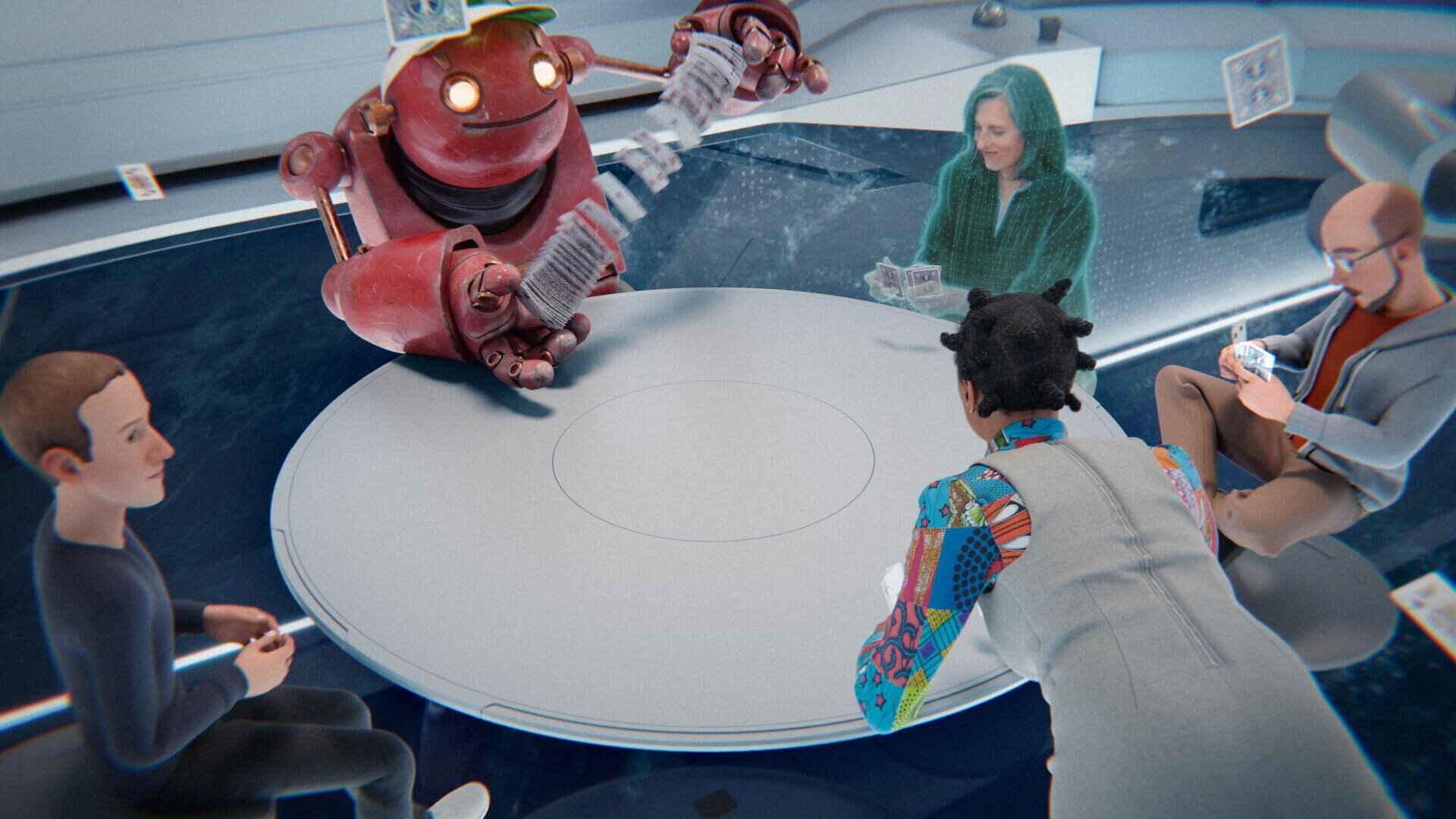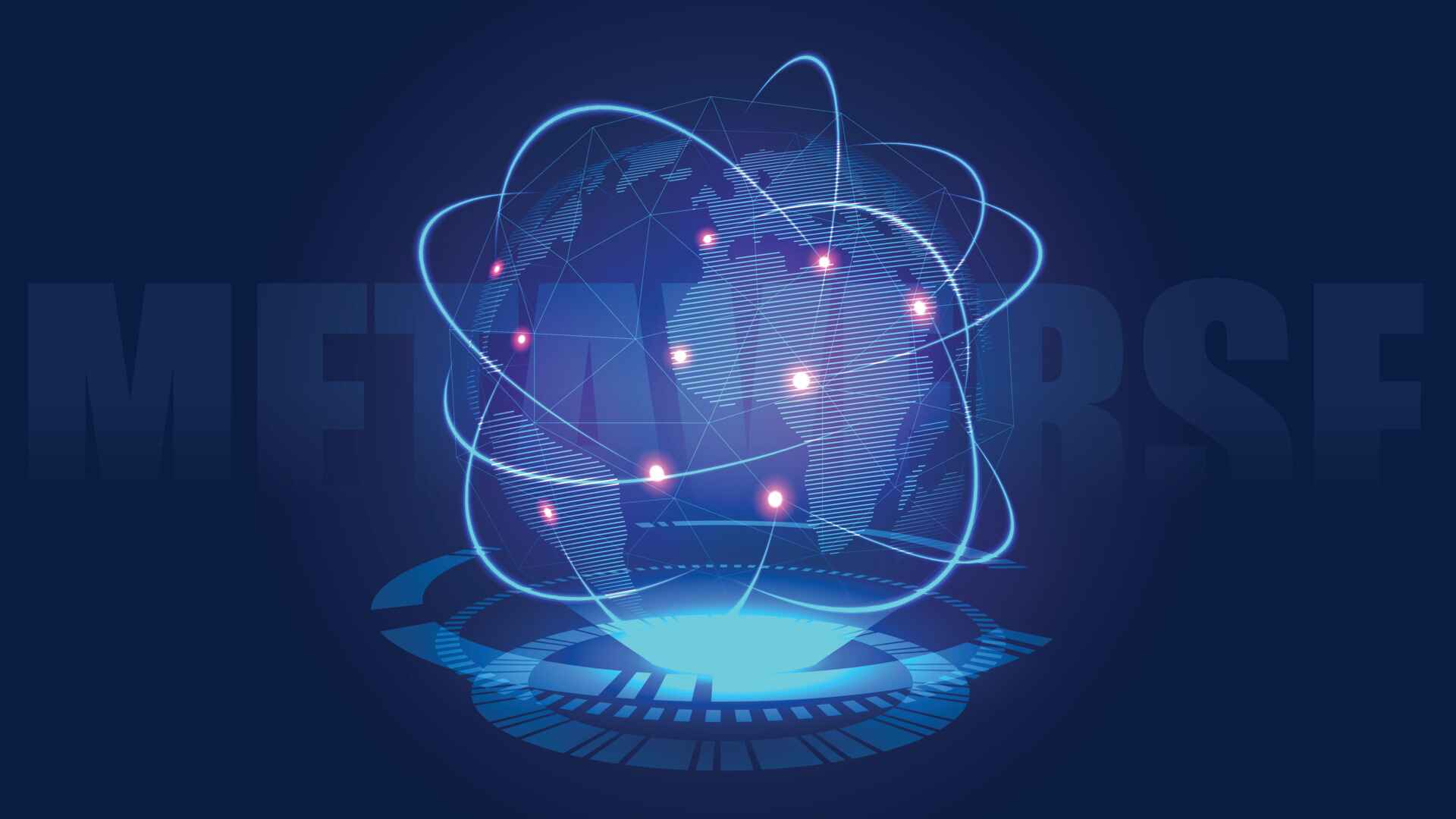Introduction
Welcome to the fascinating realm of the Metaverse, where virtual reality and augmented reality merge to create immersive digital experiences. The Metaverse has become a popular buzzword, capturing the imaginations of individuals and businesses alike. As a result, there has been a surge of interest in developing for the Metaverse.
The concept of the Metaverse originated from science fiction, but it has become a tangible reality in recent years. It is a virtual universe where people can interact with each other, engage in activities, and experience a wide range of digital content in a simulated environment.
Developing for the Metaverse offers endless possibilities for creating innovative and immersive experiences. Whether you have a background in programming, graphics design, or storytelling, there is a place for you in this evolving digital landscape.
In this article, we will explore the basics of Metaverse development, from understanding the concept to choosing the right platform, learning programming languages, designing 3D assets, creating interactive experiences, and monetizing your creations. We will also discuss important considerations such as security, privacy, and performance optimization.
By the end of this article, you will have a solid foundation to embark on your Metaverse development journey and join the growing community of creators pushing the boundaries of virtual reality and augmented reality.
Understanding the Metaverse
The Metaverse is a vast digital universe where people can engage in virtual reality experiences and interact with others in real-time. It is not limited to a single platform or device; rather, it encompasses multiple interconnected virtual worlds and augmented reality layers. Think of it as a collective virtual space where individuals can live, work, play, and explore.
In the Metaverse, users can create avatars, which serve as their digital representation, and navigate through immersive environments that span various genres and themes. From gaming to socializing, e-commerce to education, the possibilities are virtually limitless.
One key aspect of the Metaverse is its interconnectedness. It allows users to seamlessly move between different virtual worlds, carrying their digital assets and personal data with them. This interoperability promotes a sense of continuity and fluidity, enabling users to have consistent experiences regardless of the platform or application they use.
Another defining characteristic of the Metaverse is its social nature. It fosters real-time interactions and collaboration, with users able to communicate, form communities, and share experiences with one another. This social aspect adds depth and richness to the virtual environment, making it feel more engaging and lifelike.
Furthermore, the Metaverse thrives on user-generated content. Individuals and businesses can contribute to the virtual universe by creating and sharing their own 3D assets, virtual worlds, and interactive experiences. This democratization of content creation allows for infinite possibilities and encourages innovation and creativity.
While the Metaverse is often associated with virtual reality (VR) and augmented reality (AR), it is important to note that it is not limited to these technologies alone. It is an umbrella term that encompasses various immersive and interactive technologies, including mixed reality and extended reality. These technologies combine to create a multifaceted digital space that blurs the line between the real and virtual worlds.
As the Metaverse continues to evolve, it has the potential to revolutionize numerous industries, from entertainment and gaming to education, healthcare, and beyond. It opens up new avenues for communication, collaboration, and expression, offering a dynamic and interconnected virtual realm that complements and enhances our physical reality.
Getting Started with Metaverse Development
If you are eager to dive into the world of Metaverse development, here are some steps to help you get started:
1. Define Your Goals: Start by clarifying your objectives and what you hope to achieve in the Metaverse. Are you interested in creating games, virtual experiences, or virtual commerce? Defining your goals will help you focus your efforts and choose the right development path.
2. Acquire the Necessary Skills: Metaverse development requires a combination of technical and creative skills. Depending on your goals, you may need to learn programming languages, 3D modeling, animation, or storytelling. Invest time in acquiring skills relevant to your chosen area of development.
3. Research Metaverse Platforms: Explore different Metaverse platforms available in the market. Each platform has its own specifications, features, and community. Consider factors such as compatibility with your skills, target audience, and monetization options to find the platform that aligns with your goals.
4. Learn Metaverse Programming Languages: Metaverse development often involves programming, so familiarize yourself with the programming languages commonly used in the Metaverse. Some popular languages include C#, JavaScript, and Python. Understanding these languages will enable you to build interactive experiences and virtual worlds.
5. Utilize Metaverse Development Tools: Metaverse development tools can streamline the creation process and provide you with the necessary resources. These tools include integrated development environments (IDEs), 3D modeling software, game engines, and virtual reality development kits. Explore and experiment with these tools to enhance your development workflow.
6. Join Metaverse Communities: Connect with like-minded individuals in the Metaverse development community. Engage in forums, social networks, and online communities where you can ask questions, collaborate on projects, and stay updated with the latest trends and developments.
7. Start Building and Iterating: Put your skills and knowledge into practice by creating your first Metaverse project. Begin with smaller, achievable goals and gradually work your way up. Learn from your mistakes and iterate on your projects, continuously improving your skills and expanding your portfolio.
8. Stay Updated and Embrace Changes: The Metaverse is a rapidly evolving field, so staying updated with the latest technologies, trends, and techniques is crucial. Embrace changes and be adaptable, as new platforms, tools, and best practices emerge regularly.
Embarking on your Metaverse development journey requires dedication, persistence, and a passion for immersive experiences. By following these steps and staying committed to learning and growth, you can unleash your creativity and contribute to shaping the future of the Metaverse.
Choosing the Right Metaverse Platform
As the Metaverse continues to gain momentum, various platforms have emerged, each offering unique features and capabilities. Choosing the right Metaverse platform is crucial to ensure that your development efforts align with your goals and target audience.
1. Evaluate Platform Features: Start by evaluating the features and functionalities offered by different Metaverse platforms. Consider aspects such as immersive experiences, user interaction capabilities, content creation tools, cross-platform compatibility, and monetization options. Look for platforms that offer the features most relevant to your development plans.
2. Community and User Base: Assess the size and engagement of the platform’s community and user base. A thriving community indicates an active developer ecosystem, which can provide support, collaboration opportunities, and a wider audience for your creations. Engaging with a passionate Metaverse community can enhance your development experience and increase the visibility of your projects.
3. Scalability and Performance: Consider the scalability and performance capabilities of the platforms you are considering. Will it be able to handle large numbers of concurrent users without compromising on the experience? A platform that offers robust infrastructure and can handle high traffic volumes is essential, especially for applications that involve multiplayer experiences or virtual events.
4. Platform Compatibility: Ensure that the Metaverse platform you choose is compatible with your target devices and platforms. Whether you are developing for virtual reality headsets, mobile devices, or augmented reality glasses, it’s important to select a platform that supports your target hardware. This compatibility will ensure that your experiences reach the widest possible audience.
5. Developer Tools and Documentation: Evaluate the availability of comprehensive developer tools, APIs, and documentation provided by the platform. User-friendly tools and well-documented APIs can streamline the development process and simplify integration with existing systems. Accessible support materials and community-driven resources can also facilitate the learning curve for new developers.
6. Monetization Options: Consider the platform’s monetization options and how they align with your business model. Some platforms provide built-in mechanisms for generating revenue, such as in-app purchases, advertising, or virtual goods marketplaces. Evaluate whether these options suit your objectives and if they offer a sustainable path for monetizing your Metaverse creations.
7. Long-term Viability: Assess the long-term viability and growth potential of the platform. Look for indicators such as funding, partnerships, roadmap transparency, and active community engagement. Choosing a platform with a solid foundation and a future-oriented vision can provide stability and opportunities for growth as the Metaverse ecosystem expands.
8. User Feedback and Reviews: Seek user feedback and reviews to gather insights from developers and users who have experience with the platform. Learn from their experiences, strengths, and limitations to make an informed decision. Consider factors such as ease of use, support responsiveness, platform stability, and the overall satisfaction of users.
Selecting the right Metaverse platform is a crucial decision that will impact the success and reach of your Metaverse development projects. By thoroughly evaluating the features, community, compatibility, developer support, and monetization options, you can make an informed choice and position yourself for success in the evolving landscape of the Metaverse.
Learning Metaverse Programming Languages
When it comes to Metaverse development, proficiency in programming languages is essential to bring your virtual experiences to life. Here are some programming languages commonly used in the Metaverse that you should consider learning:
1. C#: C# (pronounced C-sharp) is a versatile language widely used in Metaverse development. It is primarily associated with the Unity game engine, which is popular for creating immersive virtual reality and augmented reality experiences. C# offers a powerful and intuitive syntax, making it a great choice for developing interactive and visually appealing Metaverse applications.
2. JavaScript: JavaScript is a versatile programming language that is widely used in web development and is also applicable in the Metaverse. JavaScript allows for the creation of interactive elements and dynamic behaviors within virtual environments. It is commonly used in Metaverse platforms that incorporate web-based technologies or interfaces.
3. Python: Python is a high-level, user-friendly programming language known for its simplicity and readability. While it may not be as commonly used in Metaverse development as C# or JavaScript, Python can still play a role in scripting and automation tasks within the Metaverse. It is often used for building tools, utilities, and backend systems that support Metaverse applications.
4. Shader Languages: Shader languages, such as HLSL (High-Level Shading Language) for DirectX and GLSL (OpenGL Shading Language) for OpenGL, are specialized programming languages used to define the behavior of graphics processing units (GPUs). Understanding shader languages is essential for creating visually stunning 3D graphics in the Metaverse.
5. Web-Based Languages: In addition to JavaScript, familiarity with web-based languages like HTML (Hypertext Markup Language) and CSS (Cascading Style Sheets) can be beneficial. As web technologies play a significant role in many Metaverse platforms, understanding how to manipulate HTML and CSS can help you create engaging web-based interfaces within virtual environments.
6. VR/AR-Specific Frameworks: Some Metaverse platforms offer their own framework or SDK (Software Development Kit) for virtual reality and augmented reality development. These frameworks often have their own specialized programming languages or extensions, such as Oculus SDK’s Unity integration with C#, or ARKit’s integration with Swift. Familiarize yourself with these frameworks and the associated programming languages to work effectively within their respective ecosystems.
7. Learning Resources: To learn these programming languages, take advantage of the vast array of online tutorials, documentation, and community resources available. Online learning platforms, coding bootcamps, and Metaverse-specific forums can provide valuable guidance and support as you build your programming skills.
Remember, learning programming languages is an ongoing process. As technology evolves and new opportunities arise in the Metaverse, it’s crucial to stay updated and continuously enhance your skills in the languages relevant to your Metaverse development journey. By investing time and effort into learning these programming languages, you’ll be equipped with the tools to bring your Metaverse ideas to life and create truly immersive digital experiences.
Developing 3D Assets for the Metaverse
In the Metaverse, 3D assets play a crucial role in creating immersive and visually appealing experiences. Whether you’re building virtual worlds, characters, or objects, here are some key considerations and steps to develop 3D assets for the Metaverse:
1. Conceptualize and Plan: Start by conceptualizing your 3D asset ideas and creating a plan. Define the purpose, style, and specifications of the asset. Consider factors such as polygon count, texture resolution, and animation requirements. Sketch or use 3D modeling software to visualize your ideas before diving into production.
2. Choose a 3D Modeling Software: Select a 3D modeling software that suits your needs and skill level. Popular software options include Blender, Autodesk Maya, and 3ds Max. Learn the tools and features of the chosen software to efficiently create and manipulate 3D objects.
3. Master 3D Modeling Techniques: Become proficient in essential 3D modeling techniques such as creating and manipulating vertices, edges, and polygons. Learn about efficient UV mapping, which involves unwrapping the 3D model to apply textures accurately. Practice techniques like sculpting, extruding, and beveling to add details and refine the overall shape.
4. Create High-Quality Textures: Texturing brings life and realism to 3D assets. Learn texture painting techniques to create unique surface details, colors, and materials for your assets. Master the use of tools like Photoshop, Substance Painter, or Quixel to design high-resolution textures that enhance the visual appeal of your 3D assets.
5. Rigging and Animation: If your 3D assets require animation, learn about rigging, which involves creating a skeletal structure for your models. Explore animation techniques such as keyframing, inverse kinematics (IK), and physics simulations to give life and motion to your assets. Consider the specific requirements of the target Metaverse platform in terms of supported animation formats and capabilities.
6. Test and Optimize: After creating your 3D assets, thoroughly test them within the target Metaverse platform. Check for any issues with geometry, textures, or animations and make necessary adjustments. Additionally, optimize your assets to ensure they are efficient in terms of polygon count, texture size, and rendering performance. Optimization is crucial for a smooth and immersive experience within the Metaverse.
7. Collaboration and Asset Marketplaces: Consider collaborating with other artists and developers to leverage their expertise and expand your asset library. Explore asset marketplaces and communities where you can share and sell your 3D assets. These marketplaces can be a great resource for discovering pre-made assets or reaching a wider audience with your creations.
8. Continuous Learning and Improvement: The field of 3D asset development is constantly evolving. Stay updated with the latest trends, technologies, and tools. Engage with the 3D modeling and Metaverse development communities to learn from others and embrace feedback. By continuously learning and improving your skills, you can create high-quality and impactful 3D assets for the Metaverse.
Developing 3D assets for the Metaverse requires creativity, technical skills, and attention to detail. By following these steps, you can create visually stunning and immersive experiences that contribute to the ever-expanding digital universe of the Metaverse.
Designing Interactive Experiences in the Metaverse
Designing interactive experiences is at the heart of Metaverse development. By creating engaging and immersive experiences, you can captivate users and leave a lasting impact. Here are some key considerations and steps for designing interactive experiences in the Metaverse:
1. Define Objectives and Target Audience: Start by defining the objectives of your interactive experience. What do you want users to achieve or feel? Consider the target audience and tailor the experience to their interests and preferences. Understanding your audience will help you design an experience that resonates with them.
2. Establish a Compelling Storyline: Stories are a powerful tool in creating memorable experiences. Develop a compelling storyline that guides users through the interactive experience. Consider elements such as characters, settings, conflicts, and resolutions. Immerse users in the narrative and make their actions and choices impact the outcome.
3. Focus on User Engagement: Engage users by providing meaningful and interactive elements. Incorporate gameplay mechanics, puzzles, challenges, or social interactions to keep users engaged and invested in the experience. Encourage exploration, discovery, and interaction with the environment and other users.
4. Design Intuitive User Interfaces: User interfaces in the Metaverse should be intuitive and easy to navigate. Create visually appealing menus, buttons, and icons that guide users through the experience. Consider the limitations and capabilities of different input devices such as VR controllers, keyboard and mouse, or touchscreens.
5. Utilize Audio and Visual Effects: Leverage audio and visual effects to enhance the immersive nature of the Metaverse. Use sound effects and background music to create ambiance and evoke emotions. Employ visual effects such as particle systems, shaders, or lighting techniques to add depth and interactivity to the virtual environment.
6. Test and Iterate: Regularly test your interactive experience to gather feedback and identify areas for improvement. Consider user testing sessions to observe how users interact with your experience and iterate based on their feedback. Make adjustments to gameplay, pacing, or user interface elements to enhance the overall user experience.
7. Consider Social and Collaborative Elements: The Metaverse offers opportunities for shared experiences. Incorporate social and collaborative elements into your interactive experience, allowing users to interact with others, form communities, and cooperate on challenges. Foster a sense of belonging and connection within the virtual environment.
8. Stay Updated with Metaverse Trends: The Metaverse is a rapidly evolving field, with new technologies and trends emerging regularly. Stay updated with the latest developments in Metaverse platforms, tools, and user preferences. Embrace innovation and adapt your interactive experiences to leverage the latest technological advancements.
Designing interactive experiences in the Metaverse requires a combination of creativity, technical knowledge, and user-centric thinking. By following these steps, you can create awe-inspiring experiences that engage users and leave a lasting impression in the ever-expanding world of the Metaverse.
Exploring Metaverse SDKs and APIs
Metaverse Software Development Kits (SDKs) and Application Programming Interfaces (APIs) are essential tools that empower developers to create innovative and interactive experiences within the Metaverse. These resources provide access to platform-specific features, functionalities, and data. Here are key considerations and steps for exploring Metaverse SDKs and APIs:
1. Research Metaverse Platforms: Begin by researching different Metaverse platforms and identifying the ones that align with your development goals. Look for platforms that offer robust SDKs and APIs, allowing you to leverage platform-specific features and capabilities. Consider factors such as platform compatibility, community support, and documentation quality.
2. Identify Supported Technologies: Take note of the supported technologies within the SDKs and APIs. Metaverse platforms often integrate technologies such as virtual reality (VR), augmented reality (AR), multiplayer networking, physics simulations, or machine learning. Choose platforms that align with your technical requirements and expertise.
3. Familiarize Yourself with SDK Documentation: Dive into the SDK documentation provided by the Metaverse platforms. Read through the guides, reference materials, and sample code to understand the available features and how to utilize the SDK effectively. Familiarize yourself with the provided APIs and their purpose within the platform ecosystem.
4. Explore Sample Projects: Many Metaverse SDKs offer sample projects or tutorials that showcase the capabilities and best practices of the platform. Explore these resources to gain hands-on experience and insight into building Metaverse applications. Experiment with the provided code and modify it to better understand how the SDK functions.
5. Join Developer Communities: Engage with the developer communities associated with the Metaverse platforms. Join forums, discussion boards, or developer groups where you can connect with fellow developers, ask questions, and share insights. Collaborate on projects and learn from others’ experiences to enhance your understanding of the SDKs and APIs.
6. Build Prototypes: Start building prototypes using the SDKs and APIs. Begin with simple projects to get acquainted with the development workflow, integrate platform-specific features, and test functionality. As you gain proficiency, you can gradually work on more complex projects that leverage the full potential of the SDKs and APIs.
7. Iterate and Refine: Throughout the development process, iterate and refine your projects. Seek feedback from users and developers, and incorporate their insights into future iterations. Use the SDKs and APIs to enhance user experience, optimize performance, and expand the capabilities of your Metaverse applications.
8. Stay Updated: The Metaverse landscape is constantly evolving, with SDKs and APIs evolving alongside it. Stay updated with the latest releases, updates, and features made available by the Metaverse platforms. Regularly check the documentation and join platform-specific developer mailing lists to stay informed about improvements and changes within the SDKs and APIs.
Exploring Metaverse SDKs and APIs allows you to leverage the power of platform-specific features, functionalities, and data. By researching, familiarizing yourself with the documentation, joining developer communities, and building prototypes, you can unlock the full potential of these resources and create immersive, interactive experiences within the Metaverse.
Security and Privacy Considerations in the Metaverse
As the Metaverse expands and becomes more integrated into our daily lives, it is crucial to address security and privacy considerations. Here are key factors to keep in mind when developing and engaging with the Metaverse:
1. User Data Protection: Safeguarding user data is paramount. Ensure that user data, such as personal information and payment details, is collected, processed, and stored securely. Implement strong encryption algorithms and follow best practices for data privacy to protect user information from unauthorized access and breaches.
2. Privacy Settings and Consent: Provide clear privacy settings and consent mechanisms that allow users to control the information they share within the Metaverse. Give users the ability to manage their privacy preferences, control data collection, and understand how their data is being used. Transparency and informed consent are critical in fostering trust and respecting user privacy.
3. Secure Authentication and Access Control: Implement robust authentication mechanisms to verify the identity of users and prevent unauthorized access to Metaverse applications and platforms. Utilize secure protocols such as two-factor authentication (2FA) and multi-factor authentication (MFA) to reinforce user account security.
4. Anti-Cheating Measures: In multiplayer Metaverse applications, incorporate anti-cheating measures to ensure fair gameplay and maintain a competitive environment. Implement mechanisms to detect and prevent cheating practices, such as unauthorized modifications or exploits, to maintain the integrity and enjoyment of the Metaverse experience.
5. Copyright and Intellectual Property: Respect copyright and intellectual property laws when creating and sharing content within the Metaverse. Obtain necessary permissions for using copyrighted materials and ensure that your creations do not infringe upon the intellectual property rights of others. Encourage a culture of fair use and respect for original creators.
6. Secure Transactions and Financial Data: If your Metaverse applications involve financial transactions, prioritize secure payment gateways and compliance with industry standards. Implement encryption and follow best practices for handling financial data to protect user transactions from unauthorized access and fraud.
7. Regular Vulnerability Assessments: Conduct regular vulnerability assessments and penetration testing to identify and address security vulnerabilities in your Metaverse applications and platforms. Keep up-to-date with security patches and updates, and follow best practices for secure coding and development.
8. User Education and Awareness: Educate Metaverse users about security and privacy best practices. Raise awareness about potential risks, such as phishing attacks, social engineering, and data breaches. Promote responsible digital citizenship and encourage users to adopt strong security measures to protect their personal information within the Metaverse.
As the Metaverse continues to evolve, it is vital to prioritize security and privacy considerations. By implementing robust security measures, respecting user privacy, and promoting responsible digital practices, we can ensure that the Metaverse remains a safe and trustworthy environment for all users.
Optimizing Performance in the Metaverse
Optimizing performance is vital to ensure smooth and immersive experiences within the Metaverse. Here are some key considerations and techniques to optimize performance in Metaverse development:
1. Efficient Asset Management: Optimize 3D assets, textures, and audio files to reduce file size and load times. Use efficient compression algorithms and formats to maintain visual quality while minimizing resource requirements.
2. Level of Detail (LOD) Optimization: Implement Level of Detail techniques to dynamically adjust the level of detail for 3D models based on their distance from the viewer. This optimization technique reduces the number of polygons and improves rendering performance without compromising visual quality.
3. Streaming and Caching: Utilize streaming and caching techniques to load assets and content progressively, based on user proximity and interaction. Stream assets on-demand to reduce initial load times and prioritize essential assets required for the current user experience.
4. Render Batching and Instancing: Combine multiple objects or entities into batches and use hardware instancing to reduce draw calls and CPU overhead. This optimization technique improves rendering performance by minimizing the number of API calls required for rendering objects in the scene.
5. Dynamic Loading and Unloading: Implement dynamic loading and unloading of assets based on user proximity or interaction to optimize memory usage. Load assets when they are needed and unload them when they are no longer in use to free up resources and maintain optimal performance.
6. Network Optimization: When developing multiplayer Metaverse applications, optimize network communications to minimize latency and bandwidth usage. Implement techniques such as client-side prediction, server interpolation, and network compression to ensure smooth and responsive multiplayer experiences.
7. Platform-Specific Optimization: Familiarize yourself with platform-specific optimization techniques and guidelines provided by the Metaverse platforms. Different platforms may have specific recommendations for performance optimization, targeting hardware capabilities or best practices within their respective ecosystems.
8. Performance Profiling and Analysis: Use performance profiling and analysis tools to identify performance bottlenecks. Monitor frame rates, memory usage, and resource utilization during runtime to pinpoint areas that require optimization. Optimize the identified areas to ensure a fluid and responsive Metaverse experience.
9. User Configuration Options: Provide users with configuration options to adjust graphics settings and performance preferences according to their device capabilities and personal preferences. This empowers users to optimize the Metaverse experience based on their specific hardware and networking conditions.
10. Continuous Testing and Optimization: Regularly test and optimize your Metaverse applications throughout the development process. Conduct performance testing on different target platforms and devices to ensure consistent and optimal performance across a range of configurations.
By implementing these optimization techniques and considering platform-specific guidelines, you can create Metaverse applications that deliver seamless, high-performance experiences, enhancing immersion and user satisfaction in the dynamic and fast-paced world of the Metaverse.
Monetizing Your Metaverse Creations
Monetizing your Metaverse creations allows you to turn your passion for development into a sustainable venture. Here are some key considerations and strategies for monetizing your Metaverse creations:
1. Virtual Asset Sales: Create and sell virtual assets within the Metaverse, such as 3D models, avatars, or in-game items. Utilize virtual marketplaces and platforms that allow users to trade or purchase virtual assets, earning revenue through sales or royalties.
2. In-App Purchases: Implement in-app purchase options within your Metaverse applications. Offer additional content, features, or virtual goods that users can buy to enhance their experience. Provide value in the form of exclusive or premium content to incentivize users to make purchases.
3. Subscription Models: Offer subscription options for premium access to your Metaverse applications or exclusive content. Provide subscribers with added benefits, such as access to special events, early releases, or enhanced customization options, encouraging regular recurring revenue.
4. Advertising and Sponsorships: Incorporate advertisements within your Metaverse experiences to generate revenue. Explore partnerships with brands or sponsors who can place targeted ads or sponsored content within your applications. Ensure that the ads fit seamlessly within the Metaverse environment, enhancing rather than disrupting user experiences.
5. Virtual Real Estate: Capitalize on the demand for virtual space by creating and selling virtual real estate within the Metaverse. Offer users the opportunity to own and customize virtual properties, which can be monetized through rent, lease, or the sale of virtual land and structures.
6. Events and Experiences: Organize and monetize special events or experiences within your Metaverse applications. Offer virtual concerts, exhibitions, or workshops that users can attend for a fee. Collaborate with artists, performers, or influencers to attract an audience and generate revenue from ticket sales or sponsorships.
7. Cross-Promotion and Partnerships: Collaborate with other creators or brands in the Metaverse to cross-promote each other’s content or products. Partner with influencers or content creators to reach a wider audience and increase visibility, earning revenue through joint promotions or revenue-sharing agreements.
8. Limited Edition and Collectibles: Create limited edition or exclusive virtual items, such as special edition avatars or rare in-game items. Build scarcity and collectability around these items, allowing users to purchase or trade them for a premium price, similar to limited-edition physical collectibles.
9. Sponsorship and Brand Endorsements: Seek sponsorship or brand endorsement opportunities within your Metaverse applications. Collaborate with relevant brands or businesses to feature their products or services within your virtual worlds, creating revenue through sponsored branding or product placement.
10. Crowdfunding and Donations: Engage your community and fans by offering crowdfunding campaigns or donation options. Allow users to contribute to your development efforts voluntarily, providing them with exclusive perks or rewards as a token of appreciation.
Remember to balance revenue generation with user experience and value. Ensure that your monetization strategies enhance the overall Metaverse experience rather than compromising it. By exploring these monetization strategies and adapting them to your unique creations, you can turn your Metaverse development into a profitable venture while providing value to your users.
Conclusion
The Metaverse presents a world of boundless opportunities for developers to create immersive and interactive experiences. By understanding the concept of the Metaverse, choosing the right platform, mastering programming languages, designing captivating 3D assets, and creating interactive experiences, developers can unlock the full potential of this digital realm. Along with these creative endeavors, it is vital to consider security and privacy aspects, optimize performance, and explore monetization strategies that align with your goals and target audience.
The Metaverse is a dynamic and ever-evolving space, and staying updated with the latest trends, technologies, and best practices is crucial for success. Engaging with the Metaverse development community, continuously learning, iterating, and refining your creations will help you thrive within this rapidly growing ecosystem.
As you embark on your Metaverse development journey, remember to balance technical proficiency with creativity and user-centric design. Create experiences that engage and captivate users, allowing them to explore new worlds, connect with others, and transcend the boundaries of physical reality.
The Metaverse holds immense potential to reshape industries, revolutionize entertainment, and connect people in ways we have never imagined before. By embracing the opportunities it presents and pushing the boundaries of innovation, developers like you can play a vital role in shaping the future of the Metaverse.

























